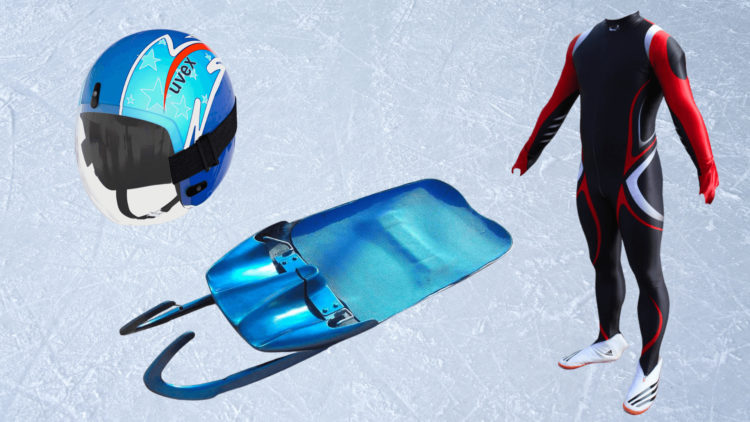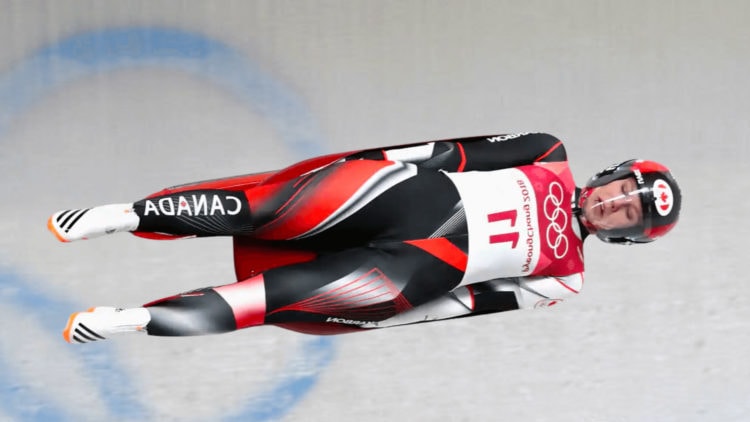
OBJECTIVE OF LUGE: Reach the finish line in less time than all other competitors.
NUMBER OF PLAYERS: 1 or 2 players per sled
MATERIALS: Sled, helmets, racing suit
TYPE OF GAME: Sport
AUDIENCE: 10+
OVERVIEW OF LUGE
Luge is a winter Olympics sport that sees competitors speed down an icy track while lying supine (on their backs) on a sled. Akin to other sled sports, such as bobsled and skeleton, athletes reach breakneck speeds, up to 90 miles an hour! Luge is frequently touted to be the fastest of the winter sled sports. If you can’t visualize exactly how fast that is, check this out:
Felix Loch (GER) Wins Men’s Luge Gold – Vancouver 2010 Winter Olympics
The sport of luge came to be partly through the craftiness of the Ancient Egyptians, who used sleds to transport materials up and down the pyramids. Later on, the Vikings were known for using actual sleds to transport materials and people through mountainous snow. However, the first recording of sleds being used for recreation to race down hills can be traced back to Norwegian chronicles from the late 1400s.
It wasn’t until the late 19th century that an international luge race came to fruition, with Switzerland hosting one featuring athletes from six different countries in 1883. The sport of luge officially gained relevance in the 1950s when the first luge world championship was held in 1955, with this later resulting in luge being an officially recognized Olympic sport just a few years later. In 1957 the International Luge Federation was founded, and the United States Luge Association in 1979.
SETUP
EQUIPMENT

Sled: Luge sleds weigh 50 pounds on average and is constructed of fiberglass and steel. This sled features two runners outfitted with steel blades to help an athlete steer. Similar to the sport of skeleton, there are no “sides” to the sled; the athlete is able to freely move around on top of the sled while holding on to two handles to help steer and avoid falling off.
Helmet: A protective helmet with a face shield to protect athletes from high-speed conditions. A must for luge equipment.
Racing Suits: Luge suits are similar to bobsled and skeleton suits; they’re tight-fitting, full-body suits made to be as aerodynamic as possible.
EVENTS
There are five main luge events:
- Men’s Singles
- Men’s Doubles Luge
- Women’s Singles
- Women’s Doubles Luge
- Team Relay
All of these are exactly what they sound like; singles are a single athlete on a sled, while doubles are two athletes on a sled who essentially lie on top of each other.
Team relay is a unique event that involves three different events in one. Races begin with a women’s single event. At the end of the run, the woman hits a large target with their hand, resulting in the next athlete’s gates being opened. This next athlete, a men’s single sled, immediately begins their run as their gate opens. Once again, they hit a large button at the end of their run, opening the gates for their final teammates. This last run is done by a men’s double team who finish the race for their team. The clock runs continuously throughout this relay, not stopping until the final doubles sled ends its run.
THE TRACKS
Unlike some of the other winter racing sports, every luge events track is unique. In fact, there are no guidelines regarding how long a track needs to be, how many curves it must have, its starting height, etc. This means luge athletes must be highly versatile and ready to adapt to any course they compete on.
Furthermore, these differences between tracks mean that there are no world records in the sport of luge; there are only track records.
GAMEPLAY

THE RACE
Olympic luge races runs begin with an athlete holding onto two handles – one on each side of the track. Then commences the six different phases an athlete goes through while generating their sled’s momentum.
GAINING MOMENTUM
- Block: This phase encompasses the movement in which an athlete initially pulls themself forward in front of the handles while generating momentum.
- Compression: This second phase begins immediately as the athlete ends the forward momentum of their block and pushes on the handles to move back to where they started. The end of this phase results in the athlete’s body being visually compressed, with the arms completely extended in front of the athlete on the handles while their head is nearly touching their feet.
- Pull: The pull phase is the initial start of the forward propulsion that’ll take the athlete down the track. This forward-pulling action transfers the athlete’s stored elastic energy from the previous phases into explosive forward momentum.
- Extension: While the pull phase is the initial start of the athlete’s forward movement, the extension phase is the continuation of that pull. “Extension” literally refers to the shoulder movement during this phase (shoulder extension).
- Push: Once the athlete’s sled passes the handles, it is no longer possible to pull the handles. Instead, to continue generating this forward propulsion, the athlete keeps their hands on the handles and pushes backward as their arms extend behind their body.
- Paddle: This final phase begins when the athlete lets go of the handles and starts digging into the ground with their spiked gloves. This action is similar to rowing with paddles in the water. After two to six paddles, the athlete immediately lays down and begins their descent.
This initial start is the most crucial part of the race, as mistakes, in the beginning can cost a sledder seconds, while errors later in the track will likely only cost them fractions of a second.
After finishing their paddle and lying down, the individual is entirely at the mercy of the course and their own minor adjustments as they slide down the track and around curves. As with any racing event, every mistake is a costly one. This is especially true for the luge, as it is one of the few events timed in thousandths of a second yet still results in the occasional tie between competitors.
Most competitions require athletes to perform two timed runs on a track. Their times are then combined.
HOW SLEDS ARE STEERED
A luge sled is controlled and steered through extremely minor bodily movements. These movements include shifting one’s weight toward different sides of the sled, pulling on the handles, and using one’s feet to contact the runners on the bottom of the sled.
Due to the sled’s fast speeds and lightweight, minor adjustments can have serious steering implications. Not only must an athlete make these crucial adjustments throughout a run, but they must also remember to keep their body as flat as possible to avoid creating any drag that would slow them down.
END OF GAME
For singles/doubles events, the team whose sled reaches the finish line in the least combined time of their two runs is the winner.
In relay/team events, the team whose three racing sleds reach their respective finish lines in the least amount of time is the winner of the event.
- 30 GAMES TO PLAY OVER TEXT - April 22, 2024
- 20+ FREE PRINTABLE BABY SHOWER GAMES - April 16, 2024
- 20+ College Party Games for the Best Night Ever! - April 2, 2024